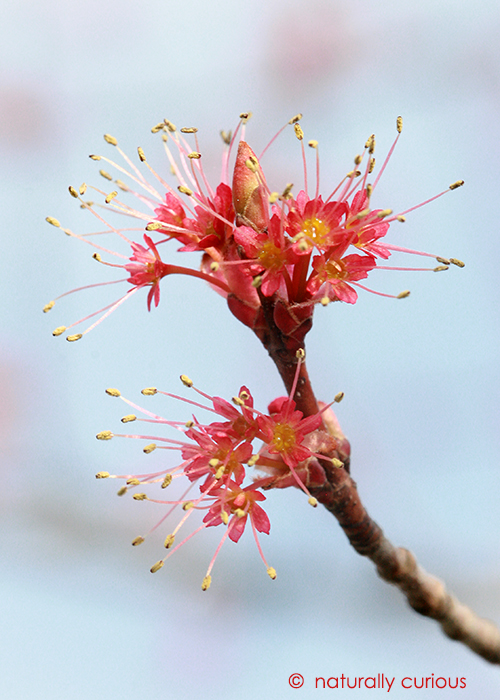Red Maples In Bloom

Red Maples (Acer rubrum) are celebrated in the fall for their vibrant colors, but they produce equally vibrant reds and yellows in early spring when they are flowering. Most Red Maples have dense clusters of either male flowers or female flowers (dioecious), although some have both male and female flowers (monoecious). Under certain conditions, a Red Maple tree can sometimes switch from male to female, male to both male and female (hermaphroditic), and hermaphroditic to female.
The showier male, or staminate, flowers contain between four and twelve stamens, with long, slender filaments and red (young) or yellow (mature) anthers at their tips. Both red sepals and petals can be seen at the base of the stamens. A staminate Red Maple in full bloom is a blaze of gold and red. (Photo: mature staminate Red Maple flowers)
Naturally Curious is supported by donations. If you choose to contribute, you may go to http://www.naturallycuriouswithmaryholland.wordpress.com and click on the yellow “donate” button.
Pitcher Plants Flowering
 Pitcher plants are known for their unique, insect-trapping leaves, but their flowers are just as unusual. Their petals are a deep burgundy color and attract pollinating flies by looking like raw meat. The sepals, usually green structures that protect the bud and then become inconspicuous when the flower opens, are leathery and remain long after the petals fall off, well into winter. The pistil, or female part of the flower, has a typical ovary at its base, where seeds are formed, but the style (stalk-like in most flowers) expands into a large, star-shaped umbrella. This umbrella becomes the lowest part of the flower as it droops downward in its early open stages and collects pollen that falls off of the anthers surrounding the ovary. The stigmas, where pollen must land in order for pollination to take place, are located on the five points of the star-shaped style, where visiting insects land. A pitcher plant is designed to be pollinated by pollen stuck to the body of the insect before the insect descends onto the lower platform section of the style, where it crawls around gathering nectar, and inadvertently, pollen. (Photo: Northern, or Purple Pitcher Plant, Sarracenia purpurea.)
Pitcher plants are known for their unique, insect-trapping leaves, but their flowers are just as unusual. Their petals are a deep burgundy color and attract pollinating flies by looking like raw meat. The sepals, usually green structures that protect the bud and then become inconspicuous when the flower opens, are leathery and remain long after the petals fall off, well into winter. The pistil, or female part of the flower, has a typical ovary at its base, where seeds are formed, but the style (stalk-like in most flowers) expands into a large, star-shaped umbrella. This umbrella becomes the lowest part of the flower as it droops downward in its early open stages and collects pollen that falls off of the anthers surrounding the ovary. The stigmas, where pollen must land in order for pollination to take place, are located on the five points of the star-shaped style, where visiting insects land. A pitcher plant is designed to be pollinated by pollen stuck to the body of the insect before the insect descends onto the lower platform section of the style, where it crawls around gathering nectar, and inadvertently, pollen. (Photo: Northern, or Purple Pitcher Plant, Sarracenia purpurea.)
Naturally Curious is supported by donations. If you choose to contribute, you may go to http://www.naturallycuriouswithmaryholland.wordpress.com and click on the yellow “donate” button.
Showy Orchis Flowering
 A walk in deciduous woodlands at this time of year could result in the sighting of several species of orchids, one of which, Showy Orchis (Galearis spectabili), has a stalk of several flowers which typically bear lavender hoods (one variant is white). Potential pollinators, most of which are long-tongued bumblebees, butterflies, moths and bees, land on a white petal below the hood which acts as a “landing pad.” The insect next heads for the tip of the nectar-filled spur located at the back of the flower. In getting there it brushes against, and often picks up, packets of pollen (pollinia) before moving on to the next blossom, where cross-pollination ideally takes place. (Thanks to Ginny Barlow for photo op.)
A walk in deciduous woodlands at this time of year could result in the sighting of several species of orchids, one of which, Showy Orchis (Galearis spectabili), has a stalk of several flowers which typically bear lavender hoods (one variant is white). Potential pollinators, most of which are long-tongued bumblebees, butterflies, moths and bees, land on a white petal below the hood which acts as a “landing pad.” The insect next heads for the tip of the nectar-filled spur located at the back of the flower. In getting there it brushes against, and often picks up, packets of pollen (pollinia) before moving on to the next blossom, where cross-pollination ideally takes place. (Thanks to Ginny Barlow for photo op.)
Naturally Curious is supported by donations. If you choose to contribute, you may go to http://www.naturallycuriouswithmaryholland.wordpress.com and click on the yellow “donate” button.


















What Other Naturally Curious People Are Saying